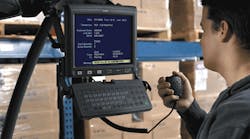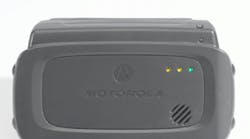In addition to scanning, the vehicle mount computers are used to give personnel daily task direction and communicate with other team members, departments and management. They use Motorla’s Team Express Voice Solution and Team Badge.
Typically this system is used with push-to-talk (PTT) devices and headsets. However, this particular manufacturing facility had specific concerns about this.
First and foremost among their priorities was safety. Forklift operators need to be able to hear what is going around them as they drive. Headsets blocked out potentially important peripheral sounds.
They also need to be able to hear management direction and commands over the communications system. This presented another problem—how can you hear directions in an extremely noisy environment? As the operators are driving the forklifts they needed a speaker that was loud and clear enough to be heard over the din.
The manufacturer engaged the DecisionPoint Systems integrators through a third party logistics company. The integrators installed Motorola Solutions’ VC5090 vehicle mount computers on the forklifts to work in conjunction with the voice system, which provides a wireless voice-over-ethernet connection (voice over IP, or VoIP).
Unlike a typical walkie-talkie where there is an independent radio channel that can be compromised by interference and traffic, the wireless VoIP is encrypted. It uses the same conduit as the barcode data and the host computer, sending information back to the recipients via VoIP. Users can communicate with everyone on a selected channel, an isolated group, or have one-on-one conversations.
Instead of a standard headset or microphone, a public safety grade PTT speaker microphone was selected, something similar to what law enforcement and fire professionals use. But the mic needed a new way to connect.
“We needed a speaker that was loud enough—but also a microphone that was clear enough—with a button that would initiate VoIP traffic,” said Bill Butler, account manager at DecisionPoint.
They also needed a unique connector and robust cable to plug in to the vehicle mount computer. The cable had to be custom built. The DecisionPoint senior systems engineer worked with the president and chief engineer of Pryme Radio Products, Dave George, to test communications.
“It was a unique application and we had to figure out how to interface our speaker mic with the computer’s requirements,” said George.
The connection was the key; but it could also be the weak link. A large facility that operates 365 days a year, 24 hours a day can be a tough environment for equipment. The system integration team determined that the average connector could be broken in just a few weeks, and that would jeopardize system communications. Pryme designed a cable and connector that could withstand continuous use.
As a result of this project, this manufacturer’s plant workers communicate information quicker and in various formats as a result of integrating wireless voice over Internet in their demanding work environment. How does that calculate into savings?
With the non-voice method, forklift drivers had to drive over to the manager, which could add five minutes to a call. If they averaged four questions a day, on an eight-hour day, that calculates to approximately 3% time utilization benefit per driver per day using the speaker system instead. At $15 per hour per driver, that is 45 cents worth of efficiency per hour per driver, or $3.60 per day. At this manufacturer’s staffing level, that would result in a payback on the speaker/mic in less than 30 days, according to the system vendor.





